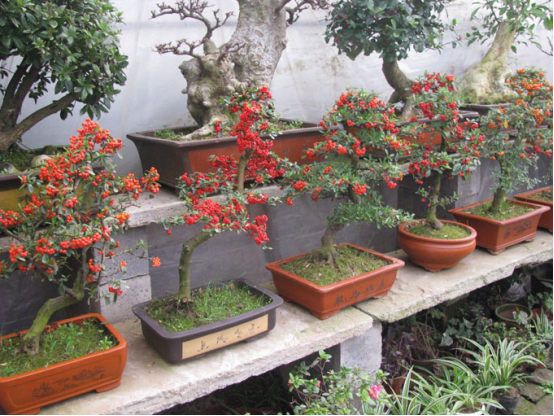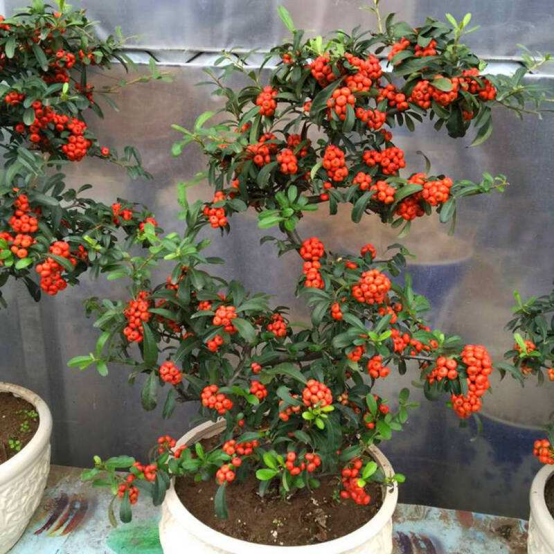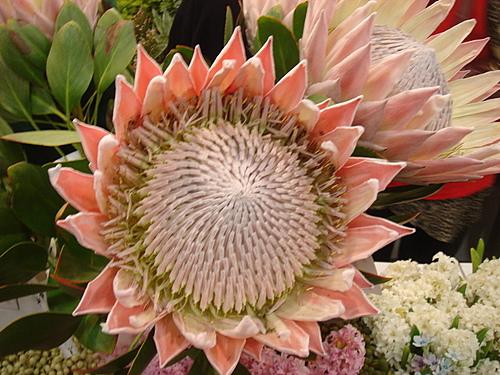Propagation Management of Pyracantha
Generally speaking, we adopt sowing propagation or cutting propagation for the propagation of Pyracantha, but the cutting propagation is simple and successful.
Cutting propagation uses annual healthy branches, cutting cuttings of 15 cm, the lower end is best cut out horseear shape, cutting time can be carried out from November to March, the success rate of cutting is very high, usually can reach more than 90%.

Propagation techniques and management measures of Pyracantha the propagation of Hippophae rhamnoides can be carried out by sowing, pressing and cutting. 1. Sowing and reproduction: every autumn, the ripe fruit with deep red skin and soft flesh is picked from the fine mother plant, crushed to remove the pulp, and then the seeds are fully washed and dried. Sow it on a pre-prepared sand bed or soil bed in spring and cover it with sand or soil about 1-3 cm thick to keep the soil moist and the seeds can germinate in about 30 days. When the seedling grows to 15 cm high, it is moved into the nursery bag or remains in the seedbed, and when the seedling grows to about 30 cm high, it is taken out and planted. If the seeds were treated with gibberellin 200 × 10-6 before sowing or soaked in 25 ℃ warm water for about 10-20 hours before sowing, it would be beneficial to seed germination. In addition to seedbed sowing, ditch sowing and hole sowing can be used. 2. Striping propagation: the crimping propagation of Pyracantha can be done by pier pressing or high pressure. ① pier pressure propagation: first pile up a certain height of fertile mound, and then select the base near the ground strong branches to press down, the appropriate part will be buried in the mound. After about 60-70 days, the new root can be cut off from the mother and then planted in the seedbed. Take out and plant after 8-10 months, or leave the strips that have grown new roots in the mound for 8 months after breaking off the mother, and then take out and plant directly. ② high pressure propagation: every spring, strong branches are selected to be girdled in the appropriate part, and the ring stripping mouth is about 1.5cm wide. The rooting matrix is wrapped with plastic film at the ring peeling mouth (0.5% naphthoic acid nna of 1% naphthoic acid 1% can promote rooting). After about 60-70 days, the new roots can be cut off from the mother when they are exposed, and can be removed and planted in the artificial seedling bed in 8-10 months. When pseudo-planting, in addition to keeping the seedbed moist, we should also pay attention to shading and maintain a certain temperature in order to improve its survival rate. 3. Cuttage propagation: select 1-2-year-old strong branches with a length of 15 cm every spring and insert them in a pre-prepared soil bed or sand bed, oblique or straight, with a depth of about 8-10 cm in length, shade and maintain soil moisture, which can be taken out and planted in March-April of the second year. Among the above propagation methods, the effect of cutting and striping (high pressure and pier pressing) is better, the plant grows fast, the time of flowering and fruiting is early, and the plants planted by striping can blossom and bear fruit in 2-3 years. Management measures: 1. Suitable place: Hippophae rhamnoides subtropical plants, sexual preference for warm and humid, well-ventilated, adequate sunshine, long sunshine environment, the optimum growth temperature of 20-30 ℃. In addition, Hippophae rhamnoides has strong cold tolerance and can grow normally at-16 ℃ and survive the winter safely. If the plant is planted in a place where the winter temperature is higher than 10 ℃, the plant dormancy is disadvantageous, which will affect the flowering and fruiting of the following year. Although Hippophae rhamnoides is resistant to barren and lax in soil, in order to grow and develop well, it is better to choose slightly acidic soil with deep soil layer, loose soil, rich organic matter, fertile soil, good drainage and ph5.5-7. 3. 2. Watering: Hippophae rhamnoides is resistant to drought, but the soil is dry in spring. It can be fertilized once before flowering and should be fully irrigated. Keep the soil dry during flowering, which is beneficial to fruit setting, so don't water too much. If the florescence is in the rainy season, we should also pay attention to digging ditches and drainage to avoid falling flowers due to too much water. After the fruit is ripe and harvested, sufficient overwintering water should be filled before entering winter dormancy. 3. Fertilization: fertilization of Pyracantha should be carried out according to different growth and development periods. During transplanting, sufficient basal fertilizer should be applied, which is mainly based on organic fertilizer such as bean cake, oil cypress, chicken manure and bone meal, and then inorganic compound fertilizer should be applied after 3 months of survival; after that, in order to promote the growth and development of branches and plants as soon as possible, fertilization should be based on nitrogen fertilizer; after plant formation, more phosphorus and potassium fertilizer should be applied every year before flowering, so as to promote plant growth and facilitate plant flowering. In order to promote fruit setting and improve fruit quality and yield during flowering, 0.2% potassium dihydrogen phosphate aqueous solution can be applied. Stopping fertilization in winter will be beneficial for Hippophae rhamnoides to pass the dormant period. 4. Shaping and pruning: Firethorn has disorderly branches under the condition of natural growth, and the overgrown, weak and over-dense branches are pruned every year to facilitate ventilation and light transmission and promote the growth of new shoots. In order to concentrate nutrition during flowering, attention should be paid to thinning when there are too many flower branches or when the inflorescences on the flower branches and the florets in each inflorescence are too dense. After the result, the fruit that is too dense on the fruit branch should also be properly removed, so that it can not only ensure the large fruit and good quality, but also avoid the "big and small year" due to the excessive fruit and nutrition consumption in the same year. Fruit branches should be pruned after fruiting every year, especially short truncated branches with only 3-4 nodes to promote the formation of fruiting mother branches and improve the yield and quality of fruit in the second year. In addition, the fruit should be picked in time after ripening, so as not to continue to consume plant nutrition, which is disadvantageous to blossom and bear fruit in the following year and affect the yield. Propagation and cultivation methods of Pyracantha
I. Reproduction
There are two main propagation methods of Hippophae rhamnoides: seed propagation and cutting propagation.
1. Seed propagation pyracantha fruit matured in October, can be stored on the tree until February of the following year, it is appropriate to collect the seeds from October to December, remove the pulp in time after harvest, rinse the seeds and dry them. It is better to sow Hippophae rhamnoides in autumn. Before sowing, the seeds can be treated with 2/10000 concentration of gibberellin, 20~30cm according to row spacing on the arranged seedling bed, deep 5cm long ditch, sowing ditch, soil covering 3cm.
2. Cutting propagation takes 1-2-year-old branches, cut 12~15cm cuttings, cut the lower end of the cuttings in the shape of a deep 10cm trench on the finished cuttings, put the cuttings at an oblique angle of 30 degrees on the edge of the trenches, the spacing of the spikes is 10cm, the upper part of the bed is exposed to 2~5cm, and the soil is firmly covered. The cutting time can be carried out from November to March of the following year, and the survival rate is generally more than 90%.
II. Afforestation
The fruit forest selected sandy loam with flat terrain and rich organic matter, dug a pit with a depth of 0.6-0.8m according to the row spacing of 2m × 2m, filled it with base fertilizer and topsoil, planted in the hole, and poured enough fixed root water.
III. Maintenance and management
1. Fertilization: base fertilizer was applied once a year from November to December, 4-6 radial ditches were dug along the tree in 80cm from root neck, deep 30cm, organic fertilizer 3~5kg was applied in each pit, urea was applied once before flowering and fruit setting stage, and 0.25kg was applied to each plant.
2. Irrigation: irrigation is decomposed before and after flowering and at the beginning of summer, which is beneficial to the growth and development of Hippophae rhamnoides. In dry and cold climate areas in winter, winter water should be irrigated once before entering the dormant period.
3. Plastic surgery: in the natural state of Hippophae rhamnoides, the crown is disorderly and irregular, and the inner branches are often slender due to lack of light, and the knot strength is poor. In order to promote growth and fruit, it should be shaped and pruned. Firethorn has strong branching ability, and most of the lateral branches are planted horizontally on the stem, which can be divided into a hierarchical shape of the trunk. The 40cm is composed of the first layer, 3-4 main branches, and the third layer is 30cm from the second layer, which is composed of 2 main branches, and there are branchlets growing between layers.
4. Pruning: Hippophae rhamnoides is easy to branch, but the continuous fruit is poor, only about 10% in the natural state, so the fruiting branches should be pruned every year, and the perennial fruiting branches should be retracted to promote the emergence of new shoots. Hippophae rhamnoides has a strong flowering ability, so it is necessary to short-poke and urge it to produce vegetative branches, and artificially or chemically remove more than half of the flower kiosks, over-dense branches and weak branches before flowering, so that the light can shine directly into the inner chamber. The annual pruning amount is based on the amount of flower branches, and the ratio of leaf to flower pavilion is 70:1.
- Prev

Modeling and making of firethorn bonsai
Firethorn bonsai should adopt the modeling method of coarse binding and fine cutting, which is generally carried out in autumn. first, iron wire or brown wire is used to roughly tie the trunk into different forms such as oblique stem or lying dry, and then it is cultivated for a period of time, and then the pile landscape layer is trimmed and shaped according to the design, so that the whole tree shape has a clear lasting appeal.
- Next

The planting method of Imperial Flower
The first method-- sowing and planting imperial flowers when sowing, it is usually chosen in autumn. First, the seeds of imperial flowers should be collected, then the seeds should be soaked for a while, then the seeds of imperial flowers should be planted in the soil, and then the soil should be kept moist. Finally, just wait for the seeds to take root and germinate.
Related
- Fuxing push coffee new agricultural production and marketing class: lack of small-scale processing plants
- Jujube rice field leisure farm deep ploughing Yilan for five years to create a space for organic food and play
- Nongyu Farm-A trial of organic papaya for brave women with advanced technology
- Four points for attention in the prevention and control of diseases and insect pests of edible fungi
- How to add nutrient solution to Edible Fungi
- Is there any good way to control edible fungus mites?
- Open Inoculation Technology of Edible Fungi
- Is there any clever way to use fertilizer for edible fungus in winter?
- What agents are used to kill the pathogens of edible fungi in the mushroom shed?
- Rapid drying of Edible Fungi

